




































































We’ve got just the right ingredients for a family dinner. Choose your base and sauce, layer with your favourite toppings, finish with shredded cheese and bake!

Available at

5 The business of bread and butter
A Nova Scotian baker gets her start with sourdough by Crystal Murray
6 All buttered up
Take your breadbasket to the next level with a beautiful butter board by Crystal Murray
8 Rooted in community
Founders House in Annapolis Royal, N.S., is a small work of art by Colleen Thompson
14 Ephemeral and fleeting Wild mushroom season brings out the foragers by Colleen Thompson
22 Freezer-friendly for future festivities
Five fun recipes to make ahead by Crystal Murray
Good Taste is a special insert in Saltscapes magazine, published by Metro Guide Publishing, 2882 Gottingen St., Halifax, N.S. B3K 3E2. Tel: 902-464-7258, Sales Toll-free: 1-877-311-5877
Contents copyright 2024/2025. No part of this publication may be reproduced without prior written consent of the publisher. Printed in Canada.



















Purchase your rst Saltscapes subscription for just $31.00 (tax included).
Gift your loved ones with a 1-year subscription for $28.00 (tax included)!
CALL: 1-877-885-6344 | 902-600-1890
EMAIL: subscriptions@saltscapes.com
ONLINE: saltscapes.com/subscriptions
MAIL: Complete the card below and mail to PO Box 190, Pictou, NS B0K 1H0
**Only valid for new subscriptions
❑ YES! Send me Saltscapes for one year – just $31.00 (tax included).




*Your Name:
*Your Mailing Address:
* City:
* Province:
* Phone: ( ) Email:



❑ I will only be the billing contact for my gift recipients, no subscription for me please.


* Postal code:
❑ Cheque enclosed Charge my: ❑ VISA ❑ MASTERCARD Card No.:
Expiry: / CVV: Signature:
❑ Sign me up for Saltscapes Viewsletter (e-newsletter) containing the latest content, online exclusive stories and contests. I understand I can withdraw my consent at any time.

Please attach another sheet with complete information for additional gift recipients.
*Required information
shipping included. Contact us for shipping rates outside of Canada.
o er: while quantities last. O er expires December 31, 2024.
Bonus: Purchase three subscriptions (or more) and receive a four pack of beautiful Saltscapes post cards mailed directly to your address! O er code: XELF
By Crystal Murray
Recipes and styling by Christena Hubbard and Allison Gaudett
Photography by Steve Smith, Visionfire

There are few things more comforting than a piece of warm homemade bread slathered with butter and molasses. It’s one of those sensory moments where I can render up a taste, a memory, and sense of place just thinking about it. The breadbasket was often on our dinner table growing up. While it’s still a typical offering at a restaurant or event dinner, bread and butter has been mostly banished from the family dinner table with many watching their carbs and sinful saturated fats. But with the return to simple pleasures and the call for comfort food in the fall, a little bread and butter can really hit the spot.
Christena Hubbard owns Crust and Crumble in New Glasgow, N.S. The home-based bakery has tummies all over her community rumbling for one of her speciality loaves with a smattering of flavoured butters. She jumped on the sourdough bandwagon after the confining days of COVID when mastering a sourdough starter became a main event on social media.
“I started experimenting with sourdough last winter,” says Hubbard, adding that her grandmother and mother baked beautiful bread.
“Growing up I always had homemade bread. I would look at the sandwiches that other kids brought to school wishing I had lunch made from storebrought bread. I didn’t know how good I had it. But my husband had the opposite experience, so homemade bread is really something special.”
Since launching her business last winter, she has been satisfying that sensory experience for a growing list of clients. For now, she keeps her distribution close to home to maintain the freshness of everything she bakes.
Sourdough is Hubbard’s bread of choice. It took her several weeks to master her unique starter formula and she’s been carefully tending to her recipe, feeding the culture and keeping it at the optimal temperature so it performs its magic in her growing repertoire of sourdough recipes that include cookies and lemon loaves.
Sourdough bread is an ancient art, known as the mother of all doughs. Makers from days long ago and modernday bakers like Hubbard keep their recipes close to their chest.
Once a starter is established, the
simplest concoction of flour and water, it grabs natural yeast from the air. How you baby that culture is the secret to success. Hubbard suggests finding a recipe in an old cookbook .
“I watched a lot of videos and made a few attempts before I got it right, and I think it will be something that will need continued learning,” she adds.
There is a science to making the starter, but once it’s going and you take care of it, you can keep a starter alive for years. Some starters get passed down through generations.
Hubbard says that while the starter can be challenging and can take a few tries, making the bread is a breeze. “It’s four ingredients: starter, flour, water, and salt. Its simplicity is why it has been an ancient art that has lasted.” She adds that during COVID when ingredients
such as yeast were scarce, people turned to sourdough to pass the time and make something comforting.
Sourdough is a food that is good for your gut, as are most fermented foods.
“Sourdough is also known to help regulate blood sugar and has a lower glycemic index than other breads so when you eat sourdough, your blood sugar does not spike,” says Hubbard, noting that some people with gluten sensitives, with the exception of celiac disease, can tolerate sourdough bread because of the way it digests.
With more science and knowledge about the gut micro-biome and how the bacteria in your gut, good and bad, can influence your overall health, there is more reason to bring back the breadbasket — if you fill it with sourdough.
Take your breadbasket to the next level with a beautiful butter board
While Christena Hubbard is not ready to give away her secret sourdough starter, she does share a few recipes that anyone can put to the test once they have made their own or talked a friend or family member into sharing a small sacred sample. You can also buy sourdough starter, but it still takes time and attention to maintain.
Hubbard, who also dabbles in interior design, collaborated with her friend and colleague Allison Gaudett to create a beautiful bread and butter board for Saltscapes that is as much a feast for the eyes as for the tummy. Christena used several of her favourite bread recipes, including a sweet little loaf of molasses sourdough, and whipped up a variety of butters to satisfy everyone’s cravings. Their creation takes the breadbasket to a new level.
Christena hopes that their creation will inspire home bakers to experiment with their own butter board designs, and has included instructions to make a
smaller board using everyone’s favourite, molasses butter.
Molasses Butter
1 cup (250 mL) unsalted butter, softened
2 tbsp (30 mL) molasses
1 tbsp (15 mL) honey
1 tsp (5 mL) cinnamon
½ tsp (2.5 mL) salt
Chopped pecans or walnuts
Dried cranberries
Orange zest
Fresh rosemary or thyme
Flaky sea salt
In a medium bowl, mix the softened butter, molasses, honey, cinnamon, and sea salt until fully combined.
Assemble the butter board: Spread
the molasses butter evenly across a wooden or marble board. Sprinkle the chopped nuts, dried cranberries, and orange zest over the butter. Garnish with fresh herbs. Rosemary or thyme add a festive touch to the dish.
Finish with flaky sea salt and serve with a variety of good breads.
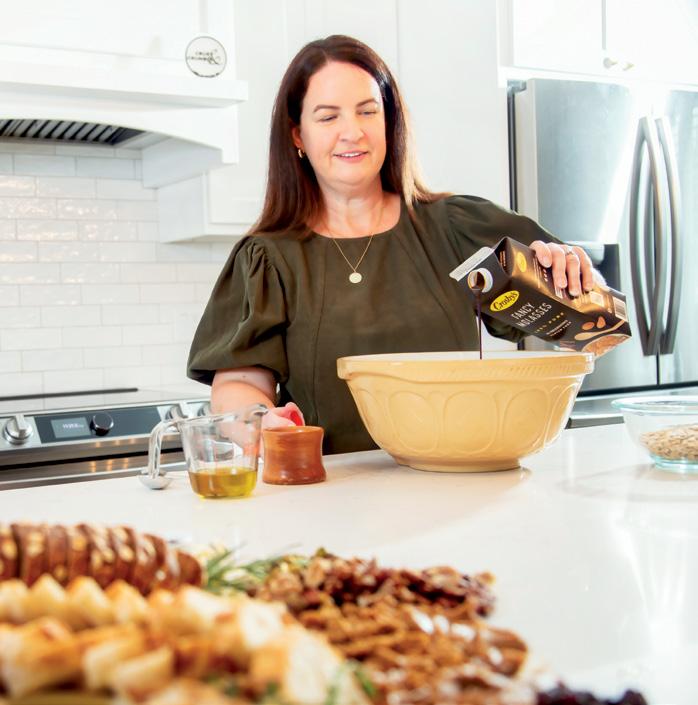

1/3 cup (79 mL) olive oil
1 tbsp (15 mL) basil, finely chopped
½ tsp (2.5 mL) red pepper flakes, crushed
¼ tsp (1 mL) salt
¼ tsp (1 mL) fresh black pepper
1 tsp (5 mL) Italian seasoning
1 tsp (5 mL) fresh garlic, minced
2 tsp (10 mL) parmesan, freshly grated
1 tbsp (15 mL) balsamic vinegar
Pour your olive oil onto your serving plate or bowl.
Add the basil, crushed red pepper, salt, pepper, Italian seasoning, garlic, and grated parmesan.
Drizzle with balsamic vinegar. Serve with your favourite sourdough focaccia.
Dough
3¾ cups (500 g) all-purpose flour
1½ cup (350 g) water
½ cup (125 mL 100 g) active sourdough starter
1½ tsp (7 ½ mL) salt
2-3 tbsp (30-45 mL) olive oil
Fresh rosemary
Flakey sea salt
Olive oil
In a large bowl, mix sourdough starter with water. Add flour and salt. Mix until all the flour is combined.
Let the dough rest for 30 minutes. After resting, perform a series of stretch and folds. Grab a section of the dough, stretch it upwards, and fold it over the rest. Rotate the bowl and repeat until you’ve done it four times. Repeat this process every 30 minutes for 2 hours. Cover the bowl and let dough rise at room temperature for about 4-6 hours, or until it has doubled in size.
Drizzle a generous amount of olive oil into a 9x13 inch baking dish. Add the dough and gently press it out so it fills the dish. Cover and let the dough proof for another 2-4 hours at room temperature, until it looks puffy.
Preheat your oven to 450F/232C. Dimple the dough with your fingers. Drizzle olive oil over the top, sprinkle with fresh rosemary, and a generous amount of flaky sea salt.
Bake for 20-25 minutes, or until the focaccia is golden brown on top. Remove from the oven and let it cool in the pan for a few minutes before transferring to a wire rack.
Serve with oil for dipping or make your favourite sandwich.






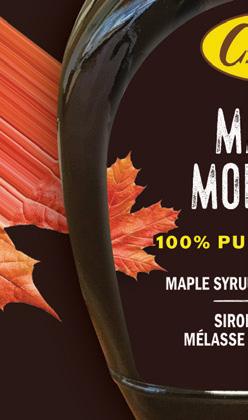















BREAD




Story by Colleen Thompson
Photography by Steve Smith, VisionFire
he best restaurants serving extraordinary and innovative food are often in tiny, rural places. Perhaps the wide-open spaces, the easy access to beautiful seasonal produce, or talented chefs choosing country life over city kitchens give rise to a wellspring of creativity. Founders House in Annapolis Royal, N.S., is a good example. Every plate from the kitchen of co-chefs Ryan Howell and Bryce Heron is a small work of art.
A Japanese cucumber and snow crab salad had me swooning for days. It featured a multitude of textures and techniques, delicate and thoughtful, with every element on the plate there for a reason. Clarified cucumber juice created a thin, crystal clear gel sheet to wrap the Nova Scotian snow crab. In contrast, the pale green, compressed raw cucumber was crisp and fresh and seasoned with a vinaigrette made from the cucumber
skins. Coins of herbed crème fraiche with anise hyssop from the restaurant’s garden dotted either side. Black beads of wild, sustainable Acadian sturgeon caviar, harvested in New Brunswick, topped everything off. This was one of eight dishes on the Founders House tasting menu, all exquisite and creative.
“We appreciate our surroundings and focus solely on what this valley has to offer,” says Chef Howell. “The incredible quality of the selection we have is truly unmatched. People in small towns have a much stronger and community-oriented passion, driven by a help-your-neighbour attitude. I’m a Newfoundlander, born and raised, and in our culture, food means everything. It signifies family and friends and is intertwined with love. It’s more than just fulfilling hunger; it resonates deeply within us. So, I’ve learned that we can’t succeed without each other, nor can
we fully appreciate the bounties of the Annapolis Valley if we don’t support one another. Those local carrots, corn, and plums signify something deeper.”
The chefs embrace an almost obsessive approach to seasonality, which means the menu changes every two weeks. It’s a snapshot of what’s in season, grown on surrounding farms in Annapolis Royal. And fewer food miles mean there is always a new and delicious star on the menu.
“Stratton’s Farm in Granville Ferry is just one great example,” says Heron. “I speak to them about three times a week to ask what’s growing, when it might be ready and how much I can be supplied, and that relationship, coupled with their adventurous growing spirit, makes our jobs as chefs very easy.”
It’s one strand of the allure that drew Heron to Founders House in the first











place. “When I lived in Toronto, I was surrounded by concrete and glass and had to drive an hour outside the core just to see what was growing in Ontario. Now, on my commute, I pass by fields of fruit and produce that I can almost hear speaking to me.”
One of the ingredients speaking to the chefs now is Roscoff onions. With a sweet taste and pale pink hues, the unmistakable French varietal is being grown by Strattons Farm for the restaurant. “I love onions in general as an ingredient, because it allows us to show off different techniques and the versatility of a humble ingredient and create a dish with cohesive variations of the same ingredient. In my personal approach to cooking, I strive to create dishes around vegetables and garnishes first and seek to elevate the ingredients,” says Heron.
Founders House is a beautiful space. A New England-style house built in 1874, painted a seaside blue with bright, whiteframed sash windows, flanked by pretty gardens, sits at the edge of the Fort View Golf Course. “From the beginning, the whole concept of the restaurant was to drive the local economy by executing a hyperlocal program, from food to drinks, to art, to labourers … you name it, we tried to keep it here,” says Laura Hamilton, the general manager.
Operating an elevated dining establishment in rural Nova Scotia comes with its challenges. Founders House has had its fair share since opening in 2018 and has had to navigate a rapidly changing hospitality world.
“We’ve learned to be very fluid and open to change, and pivoting to meet market demands is vital in this industry. Our ability to build relationships and rely on our community for support is something we would never be able to achieve in an urban setting,” says Hamilton. “We also decided to move to a tighter team and restrict the number of diners we accept during each service. Which meant that we required two strong individuals to run the kitchen.”
Co-chefs Howell and Heron work as teammates, not an easy thing to accomplish in any kitchen, particularly elevated dining driven by vision, creativity and attention to detail.
Experience the industry’s fastest ice maker* and enjoy up to 3lbs of ice, every day, with QuickIceProTM technology.

Daley’s Brand Source Home Furnishings 1840 Lincoln Rd. Fredericton, NB (506)458-9565
randall@daleysbrandsource.ca
Dave’s Appliance
1 Sandy Point Rd. Saint John, NB (506)634-1888 sales@davesappliance.ca
Creative Appliance Gallery 51 Raddall Ave., Unit 14 Dartmouth, NS (902)481-3313
info@creativeappliance.ca
Feron Kitchen Inc. 110 Chain Lake Dr., Unit 31 Halifax, NS (902)450-5144 • 1-800-565-4044 dferon@feronkitchens.com
MacArthur Appliances Inc. 96 Mount Edward Rd. Charlottetown, PEI (902)368-2200 macarthur@macarthurapp.pe.ca
Yield: 3 Loaves
8 ½ (2 L) cups of white or whole wheat flour
2 tbsp (30 mL) dry active yeast
½ cup (125 mL) unsalted butter
2 tbsp (30 mL) salt
2 tbsp (30 mL) sugar
3 cups (750 mL) lukewarm water
3 tbsp (45 mL) savoury, fresh chopped or 1 tbsp (15 mL) dried summer savoury
Sift flour into a mixing bowl. Combine yeast with sugar and water and let stand roughly 5-7 minutes until yeast is blooming and active. Melt ½ cup of butter, add bloomed yeast mixture to flour, and mix on medium speed with a dough hook, slowly adding the melted butter until fully incorporated.. Add chopped savoury to the dough and mix on medium for 5-7 minutes. Transfer the dough to a greased bowl and proof for 1 hour in a warm place.
Portion the dough into 9 evensized balls, place 3 in each bread pan, and allow the bread to proof for a second time (roughly 30 minutes). Bake the bread at 375 F/190C roughly 25 minutes or until the bread sounds hollow.
1 lb (454 gm) salted butter, room temperature
1 tbs (15 mL) of dulse, finely ground (blend dried dulse in a food processor until a fine powder) Fresh cracked pepper
With a whisk or cake mixer, whip the butter, dulse and pepper until it becomes smooth, airy, and pale.

But the menu at Founders House speaks for itself. The chefs take equal spotlight on individual creations like the P.E.I. Blue Dot beef tenderloin with charred sweet and sour cabbage, garlic scapes (the flowering stem of garlic, delicately delicious), and a crispy wonton filled with oxtail (Heron’s nod to latenight Asian eateries in big cities), and Howell’s elegant white chocolate mousse on a crumbly sablé with white crystalized white chocolate sprinkles and raspberry sorbet.
“Being a co-chef has been such a phenomenal experience. Chef Bryce possesses a vast range of knowledge and experience in many areas where I know I can improve, and I can humbly say he feels the same way about me,” says Howell. “Our different views and styles, after some fine-tuning, create a unique dining experience that strikes the perfect balance between two chefs.”
Heron and Howell have honed the formula and have kept the creative process simple. “While we are opposites in many ways, our input into dishes has a very yin and yang effect, which helps
charm the menu. We each come up with dish ideas for a date range and then sit down every two weeks to hash them out or pick the best parts and turn them into what they are. The rabbit and snails dish on our current menu is a great example of our shared vision.”
The entire team at Founders House deserve high praise for everything they've achieved in just four years. Making clever, intricate, locally sourced cuisine in a rural place, without appearing overly earnest and virtuous is not an easy thing. Founders House is charming.
I finished my two-hour dining experience with the walnut cake, a dollop of elderflower cream and a quenelle of basil ice cream. For a short while, everything felt right in the world, which is precisely the point of hospitality.
After all that, you’ll need a lie-down, and we stayed at the new Fort View Golf cottages on the same property down the road. The cottages are tranquil, Nordicstyle white and wood accommodations overlooking the golf course.
Serves 4-6

Pasta Dough
2 cups (500 mL) flour (00 flour if possible, otherwise allpurpose is fine)
6 large egg yolks
1 large whole egg
1 tbsp (15 mL) olive oil
Mix eggs and oil in a small bowl with a small whisk or fork until combined. Add the wet and dry ingredients to a stand mixer (with a hook attachment) and mix on low until combined. If the dough is too dry, add a splash of water to bring the ingredients together.
Knead on low speed in a mixer for 20 minutes, wrap tightly in cling film, and allow to rest for at least an hour in the fridge. Finished products should be moist but tacky on the hands.
Make the pasta. Dust your work area with a generous pinch of flour on a clean surface. Using a rolling pin, roll the dough out until it fits in the pasta roller.
Starting on thickness 1, feed a quarter of the pasta dough through the roller on medium speed, dust the rolled pasta with flour after every pass through the roller.
Keep repeating until you have sheets of pasta about 2 mm thick.
Cut into random shapes with a kitchen knife or pasta cutter (avoid shapes bigger than 4 square cm).
Fresh pasta should cook in salted, gently boiling water for 2-3 minutes. Serve with mushroom ragu, p. 12.
Makes 500 mL
This is a highly versatile dressing and makes about half a litre. The chefs use this dressing for a kale salad with pear, shaved Gouda, and walnuts.
6 tbsp (90 mL) balsamic vinegar
1 cup (250 mL) pomace oil or low-grade olive oil
1 shallot, diced
1 tbsp (15 mL) smooth Dijon mustard Salt to taste
Combine all ingredients in a blender and blend until smooth. Strain and salt to taste.
1 cup (250 mL) small cremini/ portobello mushrooms, diced
1 small cooking onion (such as yellow), diced
1 celery stalk, diced
6 tbsp (90 mL) marsala Salt to taste
Roast diced mushrooms on mediumhigh heat until golden brown in canola oil (or any cooking oil you prefer.)
Remove from pan, turn the heat down to low medium and sweat (gently cook without browning) onions and celery in the same fat. Add mushrooms back in and continue to cook until there is

no residual moisture in the pan (about 3-4 min depending on pan temperature; this may go quicker or slower depending on how roasted the mushrooms are).
Remove from heat and add in marsala.
Remove from pan as soon as marsala comes to a simmer, cool and store in the fridge, then season with salt to taste.
To finish this for serving, add about 100 ml of cream, and allow to reduce by half, re-season as necessary, then add your fresh cooked pasta (recipe p. 11) and toss together.








illy coffee










Little Bellies
Do what’s natural!






Maille gherkins and mustard
The Legendary Maille mustard!
Briannas Asiago Caesar Dressing
355ml
Briannas Poppy Seed Dressing
355ml
Briannas Fine Salad Dressings






A history of quality









M’Lord Whole Lychees 560ML
M’Lord Pitted Bing Cherries 398ML










M’Lord Apricots 284ML
Savour the artistry of fl avour


Tipiak Roasted Garlic


Tipiak Turmeric
Bring home a delicious and authentic experience today















Skillfully crafted wines, without the alcohol




Great Gentleman
It’s good to be great

By Colleen Thompson
Recipes and styling by Greg Burns
Photography by Steve Smith, VisionFire
As evening temperatures drop and fall rain settles in, magic happens beneath a canopy of spruce, fir, and oak, and the mushroom season in Atlantic Canada begins to flourish. Puffballs, lion’s mane, hen-of-the-woods, matsutake; beautiful to look at and poetically named, and the forest floor is a veritable feast for a few weeks.
Resembling icicles, cauliflowers, soccer balls, and human brains, they arise from beneath carpets of green moss, sprouting from tree trunks and protruding from dead logs. Some turn bright blue or red when bruised, others glow in the dark. It’s the busiest season for foragers, which means mycological
maestros are out from sunrise to sunset, traversing one end of the province to the other in search of fungi. With more than 2,000 varieties and more than 50 types of edible mushrooms, Atlantic Canada is a mycological paradise because of its diversity of microclimates, topography, and tree species.
The early, delicious fall beauties are chanterelles. The gold standard for most mushroom hunters is their distinctively peachy-apricot smell and furled, fleshy golden caps. The mushrooms are the fruit that spring from an underground web of mycelium, and if the mycelium survives, chanterelles return every year. Too much foot traffic can break the web
and over-harvesting can reduce the chances the mushrooms have to spread to new places.
Chanterelles are gregarious and grow in clusters, but always in the presence of living trees, forming a symbiotic relationship. The mushrooms draw sugar and carbohydrates from the trees’ younger roots and provide phosphorus and minerals. Despite the best efforts to cultivate chanterelles, foragers still hand-pick them in the woods, which is also why they’re so expensive and popular with chefs.
Mushrooms have unique ecological preferences, whether their relationship with a particular tree species, type
of moss, type of substrate, or their proximity to fresh or salt water. Understanding these intricate factors, what to look for, and how to predict where a particular species might be growing in abundance takes years of learning and practice.
Fred Dardenne, of Halifax-based FD Wildfoods, learned to forage for mushrooms as a young boy from his grandfather, growing up in the forests of Belgium. A master of his craft, autumn is a hectic and busy season, as he picks hundreds of kilograms of mushrooms in a day, shipping them to chefs from Halifax to Montreal. The species Dardenne picks depends on certain trees and habitats and can’t be cultivated. Wild fungi require foraging, and Dardenne picks both popular and rare species, including lobsters, blue chanterelles, and matsutake.
“Nothing smells as good as this,” says Dardenne, holding out a giant, white matsutake mushroom. Mycologist David Arora described them as “a provocative compromise between Red Hots and dirty socks.”
“When matsutakes are young, they are almost completely buried underneath the moss,” says Dardenne. “You have to look for small bumps in the moss and pat around with your hands to feel for them.” Matsutakes require more careful picking and handling than any other species because their value is determined on a graded scale. If sold to the Japanese market, they use several observable characteristics, like the veil and the completely intact base.
The popularity of foraging for fungi grows each year, but it’s essential to know your stuff. Just as there’s nothing quite like freshly made risotto ai funghi, there’s nothing like discovering your face bloating like a balloon. Although few wild mushrooms are deadly, the hazards are more likely to range from an extreme laxative effect to kidney failure.
Their presence is fleeting. September and October are typically when the highest diversity of mushrooms is out in the wild, so now is the time to gather your baskets and head into the woods. You’ll need a sharp eye, a delicate touch, and an intense nose as you search for fleshy fungi. The fun is as much in the search as in finding the treasure.
Hen of the Woods: Also known as sulphur shelf, this distinctive mushroom usually grows in abundance in stands of old oak trees. The bigger the oaks, the better chance you will find mushrooms. They grow on the ground near the base but can also be found within a couple metres of the tree. They are delicious in various ways, including sliced and pan-fried, diced for mushroom soup, or battered and deep-fried.
Puffball: If you spot what looks like a white ball in the woods, it’s likely a puffball. Typically 20 to 25 centimetres across, puffballs have no stem and lay directly on the ground. Confirm edibility by cutting the mushroom in half from top to bottom. The inside should be pure, featureless white. Discard if it’s darker.
Lion’s Mane: A striking white ball that grows on a dead log and might be overlooked by everyone except a mushroom forager. This beauty has branches that are adorned with white icicles. It is delicious when sauteed in olive oil or added to eggs or a vegetable stir fry.
Porcini: The name porcini means “piglets” in Italian. They’re also known as the king bolete, cèpe (in French), and steinpilz (the “stone mushroom” in German). Porcini mushrooms can grow a rather large cap, up to 20 centimetres in diameter and are usually brown or reddish with a thick stem and slightly sticky texture. You can find porcini mushrooms on the ground in hardwood and softwood forests throughout the region. Delicious chopped and sauteed with fresh thyme.
Hedgehog: Perhaps the easiest of all wild mushrooms to identify. Its yellow/orange cap and fruity smell resemble chanterelles, but its toothlike underbelly distinguishes it. The rich, earthy flavour makes it a great addition to stews and casseroles.
• Always cook wild mushrooms before eating. Never sample a raw wild mushroom.
• Join organizations such as the Nova Scotia Mycological Association, where you’ll learn from experts.
• Purchase a reliable mushroom foraging book with photos.
• When in doubt, throw it out. Only eat a wild mushroom if you are sure of its identity.





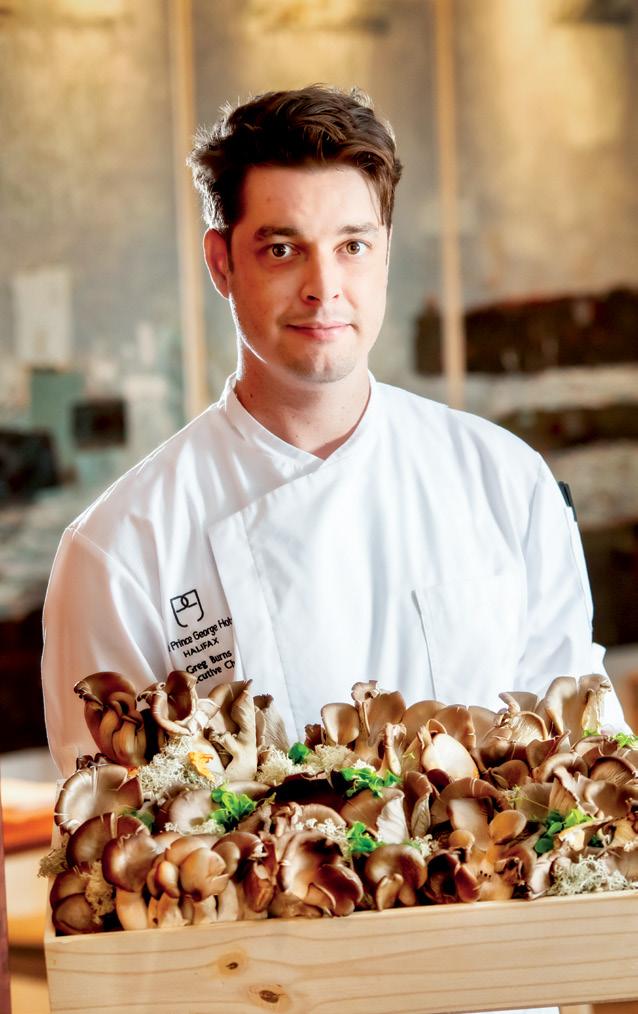
Yield: 8 slices

Pastry
2 ½ (625 mL) cups allpurpose flour
1 tsp (5 mL) salt
6 tbsp mL) unsalted butter, chilled 2/3 cup (158 mL) vegetable shortening, chilled ½ cup (125 mL) ice cold water
Mix the dry ingredients (flour and salt) in a large bowl. Place bowl in the fridge while you prepare the rest of the ingredients.
Cube the cold butter and measure out the shortening. Combine butter and shortening with your dry ingredients, using a pastry cutter or two forks. Do not overmix the dough to cut in the fat. When you are done, you should still see some larger pieces of butter and shortening.
From a cup of ice water, measure ½ cup and add slowly to your dough, a little at a time.
Stop adding water when the dough begins to form large clumps. You may not need all the water.
Fold the dough together using floured hands and refrigerate for at least two hours or up to five days.
Once your dough is formed into a 12-inch pie pan, dock it (punch holes) with a fork. Use parchment paper and fill the dough with rice or dried beans to keep the dough from puffing up.
Par bake the dough at 350F/177C for 25 minutes, until golden brown.
Mushroom Filling
8 cups (2 l) assorted mushrooms
2 shallots, finely chopped
4 garlic cloves, finely chopped
½ cup (125 mL) parsley, chopped
¼ cup (60 mL) thyme, chopped
2 tbsp (30 mL) butter
2 tbsp (30 mL) oil
Salt and pepper
½ cup (125 mL) goat cheese
1 extra shallot for pickle
Juice of 1 lemon for pickle
Slice 1 shallot and combine with lemon juice for a quick pickle.
Heat a large sauté pan to medium/ high; add butter and oil. Next, add mushrooms. Sauté down about 5 minutes. Add in garlic, shallots, and herbs. Finish sautéing for another 2 minutes.
Fill par-baked pastry with the mushroom mixture.
Top with goat cheese crumbles on top of the mushroom mixture, then finish with your pickled shallots and enjoy.
You can also make the tart ahead of time and place it in the fridge. Re-heat in a 350F/177 C oven for 20 minutes.

2 cups 500 mL) water
1 cup (250 mL) white vinegar
½ cup (125 mL) white sugar
2 tbsp (30 mL) kosher salt
1 bay leaf
1 tsp (5 mL) black peppercorns
1 cup (250 mL) chanterelles, cleaned
Add all ingredients, except the chanterelles, to a saucepan and bring to a boil.
Pour boiling pickle liquid over chantarelles. Set aside for at least 1 hour.
For Toast
sourdough bread, sliced
1 large or 2 small green tomato
1 small ripe tomato
3 garlic cloves oil for frying
¼ cup (60 mL) mayonnaise
¼ cup(60 mL) fresh basil, chopped
½ cup (125 mL) all-purpose flour
2 eggs
½ cup (125 mL) panko
½ cup (125 mL) breadcrumbs
½ cup (125 mL) canola oil
Slice the green tomatoes ¼ inch thick (or the depth of your pinky finger). Set up the breading station. You will need 3 bowls for the flour, beaten eggs, and panko/breadcrumbs. Start by covering the green tomatoes in flour. Next, dip in eggs. Then coat in panko/ breadcrumbs. Set aside.
Add ¼ cup of canola oil or other neutral oil in a small saucepan. Add garlic cloves and simmer on low for 15 minutes or until soft and golden. Strain oil. (Keep the infused oil for a salad dressing). Add chopped basil into the mayonnaise and fold in.
Grate the fresh ripe tomato on a box grater.
Toast your sourdough. Fry the green tomatoes in a frying pan with ¼ cup of oil for 1 minute per side until golden. Spread the confit garlic on sourdough toast, then spread the grated tomato on top. Add fried green tomatoes and a dollop of basil mayonnaise. Place pickled chanterelles on top and enjoy
Yield: 4 servings
¾ cup (213 mL) of light beer or sparkling water (cold)
¾ cup (213 mL) rice flour
1 tsp (5 mL) baking powder Oil for frying (canola or vegetable)
2 cups (500 mL) oyster mushrooms, torn in pieces
Whisk beer (or sparkling water) in a bowl with the rice flour until smooth. Add salt and let the mixture sit at room temperature for 10 minutes.
Heat oil to 375F/190C. Dredge mushrooms in batter, coating completely, and letting any excess drip off. Deep-fry, turning once, until golden (about 3 minutes).
Transfer to paper towel. Season with seasoning salt.
Serve with soy sauce or your favourite aioli.



























priced between $275 and $425 These suitcases are made from 70% recycled polycarbonate, offering high durability and effortless travel with their divided design and smooth-rolling Hinomoto wheels.
Shop online at takeitoutside.ca
3
TIDAL BAY 4-PACK
250ml x4 Cans (1L) $23.99









Nova Scotia’s Signature White Wine brilliantly reflects its birthplace: the terroir, coastal breezes, cool climate, and our winemakers’ world-class craftsmanship. It pairs brilliantly with our region’s seafood and is perfect for sharing with family and friends. Shop NSLC in-store or order online at mynslc.com


2
5

BUILD-YOUROWN-CANOE

$3800 incl. accommodation, instruction, and all canoe materials.














For those in your life that crave an experience! Our BYOC experience is great for those that want to learn the craft of canoe building. Stay with us on the beautiful Miramichi and at the end of the experience you have your own canoe. The perfect gift for that ‘hard to buy for’ person.

Contact Norm: 506-470-3777 norman.betts@me.com E MiramichiCanoes www.miramichicanoes.ca












From $25
priced between $60 to $225 Cotopaxi creates sustainable outdoor gear that supports both adventure and positive global change by dedicating a portion of their revenue to nonprofits improving lives.
6
$19
Shop online at trailshop.com



















Visit Amethyst Boutique for all things Amethyst! Beautiful natural amethyst pieces, fine minerals, gemstones and fossils!
63 Tacoma Drive, Dartmouth, NS www.amethystboutique.ca










































Discover over 50 authentic fragrances with our premium soy candles, hand-poured in Halifax by local artisan Lauren Burke. Renowned for their amazing scents, these candles provide a cozy, long-lasting, and eco-friendly burn that fills your space with warmth and comfort. burningflame.ca



















14












$450 incl. engraving A unique heirloom for your family. Looks great under the tree. Fresh air and red cheeks. Order your personalized traditional toboggan in time for Christmas! We will be delivering to Nova Scotia (Truro, HRM, Annapolis Valley) the weekend of Dec. 14th, order by Dec. 1st . For New Brunswick, local delivery and pick-up can be arranged, last date to order before Christmas is Dec. 7th .
Contact Norm: 506-470-3777 norman.betts@me.com E MiramichiCanoes www.miramichicanoes.ca




18
16
$12.99 – $38.99






$199



















Enjoyment for the whole family or just yourself! We carry The New York Puzzle Company, Ravensburger, Cavallini, Pomegranate, Galison and lots of others. Atlantic News 902-429-5468 @atlanticnews atlanticnews.ns.ca












$39.95









19










Designed for comfort, Esmé Jackets have a unique personality – a little edgy and original. Choose from: Fitted Jackets, Pullovers, Shorty Jackets, Blouses, Crop Tops and the new Slouchy Jackets. Produced right here in Nova Scotia. 9846 Main St, Canning, NS 902-582-7555 esmejacket.com








$28.95




















Pathway to the Stars takes readers on a remarkable journey spanning one hundred years of the Royal Canadian Air Force. . utorontopress.com
Give a gift they will love with our holiday collection soy candles. All natural, handmade in Canada. Available at LilyPond Vintage. lilypondvintage.com




















The Quarterdeck Resort is located on Summerville Beach and features 58 beautifully appointed guest rooms, each featuring a private deck facing the ocean. Pets welcome. Gift Cards available. 5 Willow Lane, Summerville Centre, NS 1-800-565-1119 quarterdeck.ca























































By Crystal Murray
Recipes and styling by Erin Pettipas
Photography by Steve Smith, VisionFire Studios
The ghost of Christmas Yet to Come is calling. It wants to remind you that it’s far more fun to prepare now and save time when the holiday season is in full swing, so we have five fantastic freezer-friendly recipes from catering chef Erin Pettipas to have you ready for planned gatherings or a surprise holiday guest. At Christmastime, you never know who might stop by!
Roasted garlic cream sauce (makes enough for lasagna and pinwheel recipe)
2 heads roasted garlic
1/4 cup (60 mL) butter
2 tbsp (30 mL) flour
½ cup (125 mL) white wine
3 cups (750 mL) heavy whipping cream
½ cup (125 mL) cream cheese
1 tsp (5 mL) salt
For the lasagna
2 lb (1 kg) butternut squash, peeled and cut into 2-cm cubes
1 leek, washed and chopped
2 cups (500 mL) ricotta
2 cups (500 mL) parmesan, grated
1 package lasagna noodles
1 head of kale, de-stemmed, roughly chopped and washed
2 tbsp (30 mL) butter
1½ tbsp + ½ tablespoons olive oil
To make the roasted garlic cream sauce, slice off the top of the head of garlic to expose the tip of each clove, wrap in foil with 2 tsp olive oil, salt and pepper and bake at 400F/204C for
1 hour or until fragrant and softened. Roast alongside the butternut squash, cubed and drizzled in the remaining olive oil and seasoned with salt and pepper. Bake for around 45 minutes or until you can easily prick with fork.
Meanwhile in a pan on medium heat, sauté the chopped leeks with butter until they soften and start to brown, about 10 minutes. Add kale and sauté until wilted and bright green. Mix in the roasted butternut squash and set aside until ready to assemble.
Combine ricotta with 1 cup parmesan cheese.
In a pot, add the roasted garlic (squeeze from the skin and mashed), combine with butter and cook on medium heat until the butter has melted and starts to bubble. Add flour and whisk continuously for about two minutes. Add white wine, cook for another couple of minutes, whisking and scraping any brown bits on the bottom of the pan. Add cream cheese and whisk until melted then slowly add heavy whipping cream while whisking. Once sauce is smooth and hot remove
from heat. Don't let the mixture boil.
This recipe makes enough for the lasagna recipe and mushroom pinwheel recipe. If making both dishes, set aside 1/4 of sauce for pinwheels.
Cook noodles to package directions in salted water and drain.
To assemble, in a large casserole dish begin layering the components, roasted garlic cream sauce, pasta, butternut squash mixture, pasta, ricotta-parmesan mixture, roasted garlic cream sauce and repeat 3 times. Pour the remaining roasted garlic cream sauce over the top layer of pasta and top with the remaining cup of parmesan and freshly-cracked black pepper. At this point, if freezing you may cover tightly and place in freezer. To cook from frozen, bake at 375F/190C covered in foil for 45 minutes. Remove foil and bake another 20 minutes until the cheese has browned.
If cooking fresh, bake uncovered at 425F/218C for 30 minutes. Let rest 10-15 minutes before digging in.

Makes 5 litres
Roast chicken. If pressed for time, skip this step and use a rotisserie chicken and make broth from it or use rotisserie chicken and store-bought broth.
Chicken and broth
1 chicken
1 medium onion, chopped
2 medium carrots, chopped
3 stalks of celery, chopped
1 apple, cut in half, then quarters
3 tbsp (45 mL) fresh mixed herbs, chopped (thyme, rosemary, sage)
3 tbsp (45 mL) butter
2 tsp (10 mL) salt
2 tsp (10 mL) pepper
Soup
1 whole chicken (meat removed from bones and pulled into bite size pieces)
8 cups (2 l) broth
1 cup (250 mL) wild rice
2 cups (500 mL) carrots, peeled and diced
1 leek, washed and chopped
3 cups (750 mL) kale, de-stemmed, washed and chopped
1 cup (250 mL) heavy whipping cream
2 tbsp (30 mL) olive oil
Preheat oven to 450F/230C. In a casserole dish scatter chopped up veggies (no need to peel anything). Melt butter with chopped herbs, salt and pepper. Place chicken on top of veggies and cover with the butter and herb mixture, including under the skin of the breasts. Roast for 15-20 minutes or until the skin has browned then lower the heat to 350F/177C and cook for 45 minutes to an hour or until chicken registers at least 165F/75C all over and the juices are running clear. Allow to cool before removing meat from bones and separating the meat into a container and refrigerate. Place bones along with any juices, veggies from the casserole dish
in a 6.7L pot. Cover and fill with water, bring to a boil, reduce heat to medium-low, cover and allow to simmer for 1-2 hours. Strain into another bowl to separate broth from bones and set aside.
In the empty pot, on medium-high heat, add butter, carrots and leeks, and sauté for 10 minutes until they start to brown and leeks soften. Add in rice and toast for 2 minutes, then add the broth, bring to a boil on high, then lower to medium heat, cover and simmer for 30 minutes until the carrots are soft to bite and the rice is cooked through. Add the chicken.
If cooking to freeze, pack into airtight containers and place in freezer. To reheat, thaw in refrigerator overnight, return to a pot and reheat, stirring in the cream and kale.
To serve fresh, stir in the cream and kale until the kale is wilted and bright green.
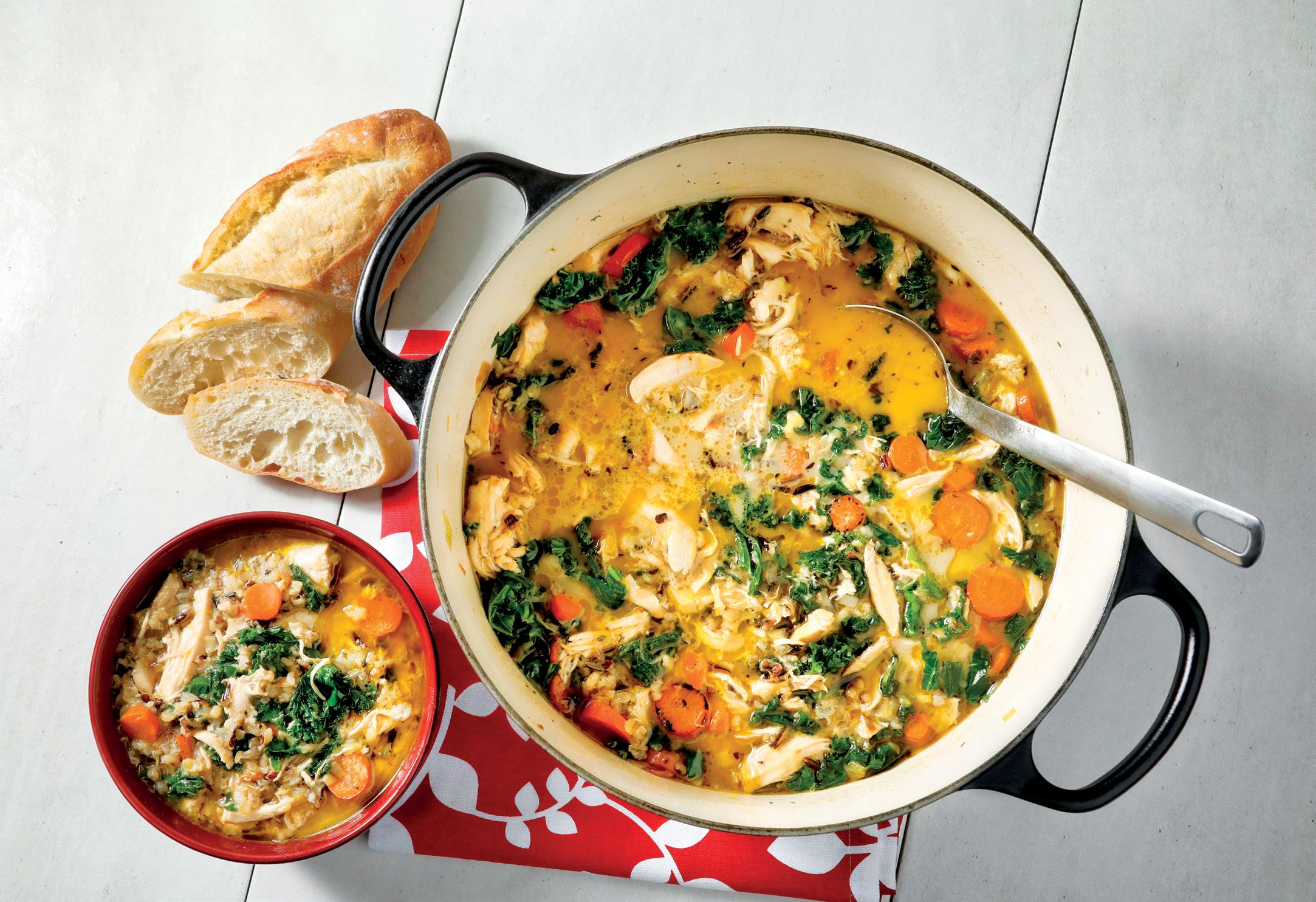



Makes 4 cups
1 lb (454 g) bacon
4-5 shallots, about one cup (250 mL) thinly sliced
2 cloves garlic, minced
1 block (250 g) cream cheese
4 ounces (113 g) goat cheese
½ cup (125 mL) sour cream
½ cup (125 mL) mayonnaise
2 cups (500 mL) shredded gruyere, divided
½ cup (125 mL) dates, pitted and roughly chopped
Dice bacon into 2-cm pieces and add to a sauté pan with sliced shallots. Cook on medium high heat for 20-30 minutes until the bacon is crisp and the shallots are browned and starting to caramelize. Drain excess oil, then add garlic and sauté 2 minutes until fragrant. Add to a mixing bowl with the remixing ingredients, reserving one cup of shredded gruyere. Combine, then spread into a baking dish, top with reserved gruyere and bake at 400F/204C for 20 minutes or until the cheese is brown and bubbling. Serve with sliced baguette or crostini.


1 lb (450 g) ground beef
3/4 lb (375 g) mild Italian sausage meat (or remove from cases)
½ cup (125 mL) panko breadcrumbs
2 eggs
3 tbsp (45 mL) olive oil
1 medium onion, diced
3 cloves garlic, minced
3 tbsp (45 mL) fresh oregano, chopped
3 tbsp (45 mL) fresh basil, chopped
3 cups (750 mL) tomato passata or tomato purée
1 ball fresh mozzarella, grated or torn into shreds
Salt and pepper
Preheat oven to 425F/208C.
In a sauce pot, add 3 tbsp olive oil with 1 clove garlic, 1 tbsp oregano and 3 tbsp basil. Sauté until fragrant then
add tomato passata. Season with 1 tsp salt and stir. Cover and simmer while you make and bake the meatballs, about 30 minutes.
Meanwhile, sauté onion with 2 tbsp olive oil on medium high for 5-10 minutes until softened and browned. Add 2 cloves minced garlic and sauté until fragrant. Add to mixing bowl with beef, sausage, 2 tbsp oregano, 2 eggs, panko, 1 tsp salt, 1 tsp pepper. Combine and form into 1.5-inch balls (you should get between 16-24.) Bake for 15 minutes or until internal temp reaches 160F/70C.
Add meatballs to a casserole dish and cover in tomato sauce and torn or grated mozzarella. Broil in oven for 3-5 minutes until the cheese is melted and browned (watch closely). Top with more fresh basil and enjoy as an appetizer or with spaghetti.














by Nova Scotia Artisan, Paul Bingham










In a 5200°f flame he works molten glass, melding and fusing colours to create pieces of lasting beauty.
Each piece is individually created and annealed in the kiln. Quality, beauty and expertise crafted into every exceptional piece.

















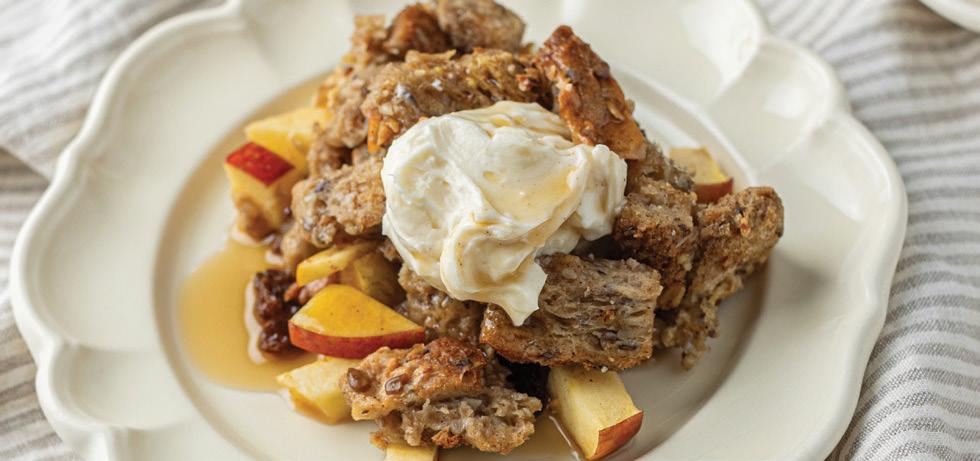








Instructions
1. Grease a 13 x 9 inch baking or casserole dish, set aside.
2. In a large bowl, whisk together milk, eggs, cinnamon, brown sugar and vanilla. Stir in raisins if using.
3. Add bread and apples to the egg mixture and mix gently to coat well. Cover and let stand for at least 20 mins or overnight. Place dish in the refrigerator if letting it stand for longer then 30 mins. If chilling overnight, remove the dish from the fridge an hour before baking.
4. Preheat oven to 350 degrees.
5. Bake until puffed and golden for about 35 mins.
6. While dish is baking, prepare icing. Using a stand mixer or mixing by hand, beat together cream cheese, milk and vanilla until smooth. Add icing sugar and start beating on a low speed so icing sugar doesn’t fly everywhere. Gradually increase the speed and beat until smooth.
7. Remove dish from the oven, top with cream cheese icing and cut into pieces to serve. Serve with maple syrup if desired.

























































1 package premade puff pastry (454g/2 sheets pastry) or homemade
1 cup (250 mL) roasted garlic cream sauce (1/4 of recipe from lasagna, above)
1 package (250 g) cremini mushrooms
1 medium onion, thinly sliced
4 oz (113 g) goat cheese
3.5 oz (100 g) prosciutto
2 tbsp (30 mL) olive oil
Balsamic drizzle
Slice onions and place into a small sauce pot with 1.5 tbsp olive oil. Turn heat to high until the onions start to sizzle and brown, then reduce to low, cover and allow to caramelize. This will take about 1 hour, stirring every 10 minutes or so. Once caramelized, add sliced mushrooms, season with salt and pepper and sauté on medium high until no moisture remains and the mushrooms are cooked down. Set aside.
To assemble, lay out the sheets of puff pastry. Spread roasted garlic cream sauce on each, then layer on prosciutto to cover. Top with caramelized onions, mushrooms and crumble goat cheese over top. Roll into pinwheels, then using a sharp serrated knife in a back-andforth motion, gently slice into 7-8 pieces. Place upright in a casserole dish. You may freeze at this point, and when ready to use, allow to defrost overnight in fridge and bake. Bake defrosted or fresh pinwheels at 425F/218C for 40-45 minutes. Top with balsamic drizzle and serve.
Sweet blue swimming crab and cream cheese in a hand-folded wonton. Enhance the moments that matter with tasty apps.




































































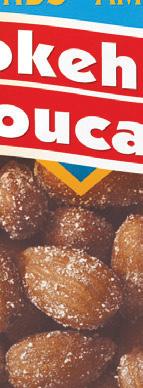























































Now is the time to get into the Subaru Solterra.
Featuring standard Full-Time Symmetical All-Wheel Drive to help you navigate any terrain and award-winning EyeSight® Driver Assist Technology to keep your whole family safe. It’s time to experience Subaru’s legendary quality and reliability brought to you by Japanese engineering.
Book a test drive at your local Atlantic Subaru dealer today.
Model shown is 2024 Solterra (RUEATC). Vehicle shown solely for purposes of illustration and may not be equipped exactly as shown. *Eyesight® is a driver-assist system, which may not operate optimally under all driving conditions. The driver is always responsible for safe and attentive driving. System effectiveness depends on many factors such as vehicle maintenance, and weather and road conditions. Based on IHS Markit Vehicles in Operation as of June 30, 2023 for Model Years 2014 to 2023 vs. Total New Registrations of those vehicles. See Owner’s Manual for complete details on system operation and limitations. Solterra and Subaru are registered trademarks. See your local Subary dealer for complete details.